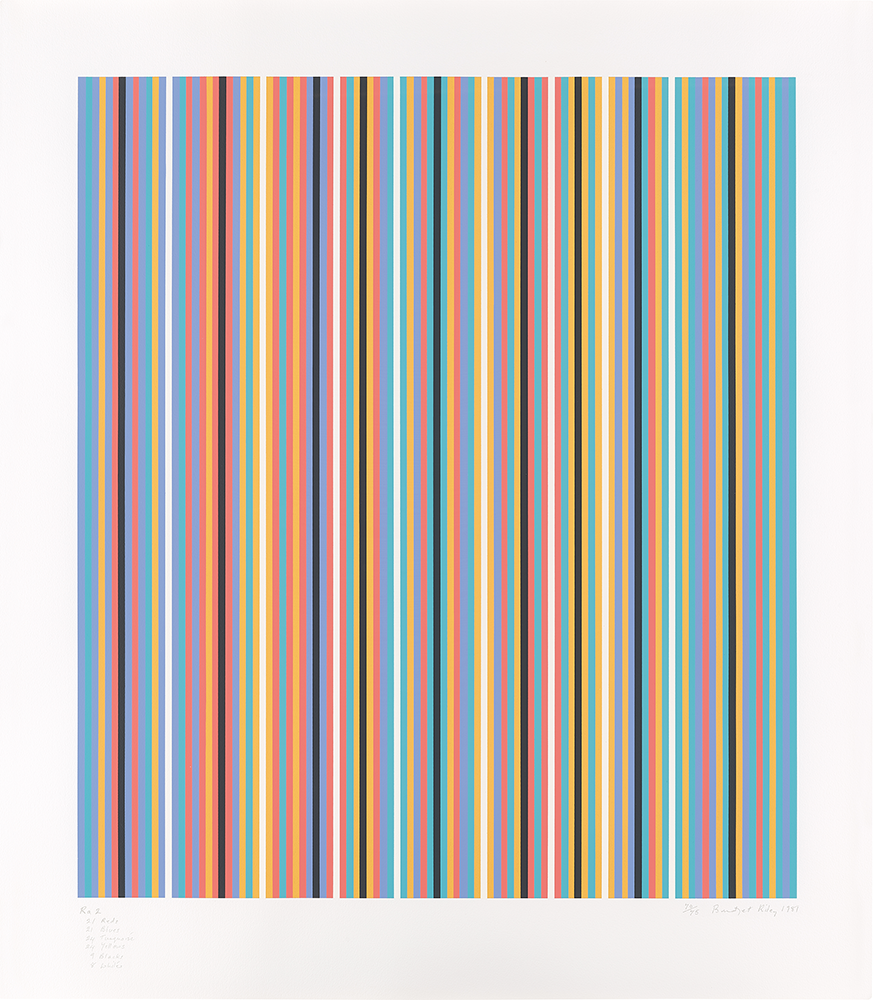BRIDGET RILEY
PRINTS 1972 – 2018
2024年6月25日(火)-8月10日(土)
25 June – 10 August 2024
日曜 月曜 祝日 休廊
Closed on Sundays, Mondays and National Holydays

1981 screenprint in 6 colours on paper 106.6 x 93.2 cm edition of 75
©Bridget Riley. All Rights Reserved, 2024
西村画廊は2024年6月に創業50周年を迎えます。
当画廊は、6月25日(火)から8月10日(土)まで、ブリジット・ライリーの版画展 “PRINTS 1972-2018”を開催いたします。本展は、作家自らが厳選したスクリーンプリント20点による、当画廊で5度目20年ぶりの個展となります。
1931年ロンドンで生まれたブリジット・ライリーは、現在最も重要で影響力のある画家の一人として国際的に評価を得ています。ゴールドスミス・カレッジ(1949-52)とロイヤル・カレッジ・オブ・アート(1952-55)で美術を学んだ彼女は、抽象的な形を駆使して錯視効果を生み出す“オプ・アート(Op Art)”の先駆者として1960年代に躍進し、既存の絵画の概念を揺るがす存在として地歩を固めました。1968年には女性として、またイギリス人としても初めてヴェネツィア・ビエンナーレ絵画部門国際賞を獲得。日本では2003年に高松宮殿下記念世界文化賞を受賞しました。
絵画史の探求と科学的知見の両翼で制作を行うライリーは、周到に調合した複数の幾何学的色面を独自の論理に従って視覚効果的に描くことで、ゆらめき知覚を撹乱する、極めて知的かつ有機的な絵画空間を創出します。自ずと能動的で没入的なものとなるその鑑賞体験において、観者の視線は画面の至るところへ絶えず誘導され、中心も序列もない、非階層的な世界をさまようことになります。それは、ルネサンス以来の西洋絵画の定石であった透視図法という “中心”を捨て去り、聖書や歴史を物語ることをやめ、やがて現実の再現的な描写からも脱却することで絵画の抽象化を推進していった近代美術の巨匠たちへの、ライリーなりの応答のように解釈できます。ライリーはかつて、「私はスーラから、色と光について、『光』は色から作り出せるという重要なことを学んだ。私は相互作用について多くを学んだ。様々な部分における『青』は、あらゆる種類の異なる役割を果たすのだ」と語りましたが、各々の色や形が固有の輝きを保持しながら相互に響き合い、全体としてゆるやかなハミングを織りなす彼女の溌剌として抒情的な抽象画に、我々は印象派/ポスト印象派の絵画を前にしたときと同じく、水面や空、緑に戯れるまばゆい光を視ることも可能でしょう。神という “中心” が希薄化した現代の市民社会を生きる寄る辺ない我々にとって、近代絵画の偉大なる達成を咀嚼し、更新したライリーの絵画は、馴染みやすく、同時に底知れぬ深度を感覚させるものとして現前します。
ライリーの仕事において、混色やにじみがなく複数の色を正確に表現できる版画技法・スクリーンプリントは、活動初期から重要な位置を占め、1962年から現在までに制作された110点近い版画作品のほぼ全てがこの技法によります。
本展では、1972年の第8回東京国際版画ビエンナーレ展(東京国立近代美術館/京都国立近代美術館)出品作で大原美術館賞を受賞した“Coloured Greys [1]”(1972)から、薔薇の豊潤な美しさを12色で表した “Rose Horizontal”(2018)まで、その多岐にわたる変遷をご覧いただけます。ぜひご期待ください。皆様のご来廊を心よりお待ちしております。
Nishimura Gallery will celebrate its 50th anniversary in June 2024.
We are pleased to present “PRINTS 1972-2018”, an exhibition of prints by Bridget Riley from 25 June to 10 August. This is the fifth solo exhibition at the gallery and the first in 20 years, featuring 20 screenprints carefully selected by the artist herself.
Born in London in 1931, Bridget Riley has gained an international reputation as one of the most important and influential painters of our time. She studied art at Goldsmiths’ College (1949–52), and later at the Royal College of Art (1952–55), and made her breakthrough in the 1960s as a pioneer of ‘Op Art’ , the use of abstract shapes to create optical illusions. In 1968 she became the first woman and the first British artist to win the International Prize for Painting at the Venice Biennale. In Japan, she was awarded the Praemium Imperiale in 2003.
Working on both wings of the exploration of the history of painting and scientific knowledge, Riley creates highly intelligent, organic paintings that fluctuate the perception through the visual effects of multiple carefully formulated geometric colour surfaces according to her own logic. In this naturally active and immersive viewing experience, the viewer’s gaze is continually guided to all parts of the screen, wandering through a non-hierarchical world with no centre and no rank. This can be interpreted as Riley’s response to the masters of modern art, who abandoned the ‘centre’ of perspective that had been a staple of Western painting since the Renaissance, stopped telling stories from the Bible or history, and eventually promoted abstraction in their paintings by breaking away from reproductive depiction of reality. Riley once said, “I learned from Seurat this important thing about colour and light, that ‘a light’ can be built from colour. I learned a great deal about interaction, that ‘a blue’ in different parts will play all sorts of different roles.” In her livery and lyrical abstract paintings, in which each colour and shape has a clear presence, yet resonates with each other, weaving a gentle hamming as a whole, we can see the dazzling light playing on the water, sky, and greenery, just as we do when we see Impressionist / Post-Impressionist paintings. For those of us who live in a contemporary civil society that has been diluted its ‘centre’ – God -, Riley’s paintings, which have digested and updated the great achievements of modern painting, present themselves as familiar, and at the same time they give us a sense of unfathomable depth.
Screenprint, a printmaking technique that accurately reproduces multiple colours without colour mixing or bleeding, has been an important part of Riley’s work since the beginning of her career. Almost all of the nearly 110 prints she hascreated from 1962 to the present day are based on this technique. In this exhibition, visitors can see the wide ranging transition from ‘Coloured Greys [1]’ (1972) , which was exhibited at the 8th Tokyo International Print Biennale (The National Museum of Modern Art, Tokyo / The National Museum of Modern Art, Kyoto) in 1972 and won the Ohara Museum of Art Prize, to ‘Rose Horizontal’ (2018), which represents the rich beauty of roses in 12 colours. We look forward to welcoming you.

2015 screenprint in black on Fabriano 5 paper 67 x 58.5 cm edition of 75
©Bridget Riley. All Rights Reserved, 2024

2009 screenprint in 3 colours plus white under print on Fabriano 5 paper 44.1 x 29.1 cm edition of 300
©Bridget Riley. All Rights Reserved, 2024

1972 screenprint in 11 colours on paper 72.6 x 73.4 cm edition of 125
©Bridget Riley. All Rights Reserved, 2024

1977 screenprint in 5 colours on paper 97.8 x 49.2 cm edition of 100
©Bridget Riley. All Rights Reserved, 2024
